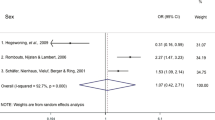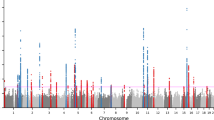Abstract
The role of heredity and its impact on the clinical severity of acne has been suggested by several studies. In 1960, Hecht [1] was the first to assess the role of heredity for acne. He demonstrated that if one of the parents had presented with acne in his/her youth, the child who resembled him/her most had 80 % probability of developing acne himself/herself. It was later resumed in several clinical studies [2–4] of which some had been performed in twins [5–7]. One study of 95 pairs of twins presenting with acne showed that 98 % of monozygotic twins were affected versus 46 % of dizygotic twins [6]. The two other ones [5, 7] confirmed this high concordance in monozygotic compared to dizygotic twins. In one of them [5] the influence of genetic factors and family history on the occurrence of acne was estimated to be 81 %. A link was shown between family factors and the susceptibility to persistence of acne into adulthood [8–10]. Finally, a recent study performed in 2006 showed that the concept of family acne is associated with an early onset of lesions characterized by greater risk of scarring and more widespread lesions [11]. When a family history can be shown to exist [9] acne is more difficult to treat, with longer treatment periods and greater risk of recurrence.
Access this chapter
Tax calculation will be finalised at checkout
Purchases are for personal use only
Similar content being viewed by others
References
Hecht H. Hereditary trends in acne vulgaris. Prevention of acne. Dermatologica. 1960;121:297–307.
Cantú JM, Gómez-Bustamente MO, González-Mendoza A, Sánchez-Corona J. Familial comedones. Evidence for autosomal dominant inheritance. Arch Dermatol. 1978;114(12):1807–9.
Friedman GD. Twin studies of disease heritability based on medical records: application to acne vulgaris. Acta Genet Med Gemellol (Roma). 1984;33(3):487–95.
Wong SS, Pritchard MH, Holt PJ. Familial acne fulminans. Clin Exp Dermatol. 1992;17(5):351–3.
Bataille V, Snieder H, MacGregor AJ, Sasieni P, Spector TD. The influence of genetics and environmental factors in the pathogenesis of acne: a twin study of acne in women. J Invest Dermatol. 2002;119(6):1317–22.
Cunliffe WJ. In: Marks R, Plewig G. Acne and related disorders: proceedings of an international symposium; Cardiff 1988. Dunitz; 1989. p. 4–6.
Swale VJ, Spector TD, Bataille VA. Sarcoidosis in monozygotic twins. Br J Dermatol. 1998;139(2):350–2.
Daniel F, Dreno B, Poli F, Auffret N, Beylot C, Bodokh I, et al. Descriptive epidemiological study of acne on scholar pupils in France during autumn 1996. Ann Dermatol Venereol. 2000;127(3):273–8.
Goulden V, McGeown CH, Cunliffe WJ. The familial risk of adult acne: a comparison between first-degree relatives of affected and unaffected individuals. Br J Dermatol. 1999;141(2):297–300.
Xu SX, Wang HL, Fan X, Sun LD, Yang S, Wang PG, et al. The familial risk of acne vulgaris in Chinese Hans – a case-control study. J Eur Acad Dermatol Venereol. 2007;21(5):602–5.
Ballanger F, Baudry P, N’Guyen JM, Khammari A, Dréno B. Heredity: a prognostic factor for acne. Dermatology. 2006;212(2):145–9.
Quéreux G, Volteau C, N’Guyen JM, Dréno B. Prospective study of risk factors of relapse after treatment of acne with oral isotretinoin. Dermatology. 2006;212(2):168–76.
Ando I, Kukita A, Soma G, Hino H. A large number of tandem repeats in the polymorphic epithelial mucin gene is associated with severe acne. J Dermatol. 1998;25(3):150–2.
Ong YC, Kolatkar PR, Yong EL. Androgen receptor mutations causing human androgen insensitivity syndromes show a key role of residue M807 in Helix 8-Helix 10 interactions and in receptor ligand-binding domain stability. Mol Hum Reprod. 2002;8(2):101–8.
Paraskevaidis A, Drakoulis N, Roots I, Orfanos CE, Zouboulis CC. Polymorphisms in the human cytochrome P-450 1A1 gene (CYP1A1) as a factor for developing acne. Dermatology. 1998;196(1):171–5.
Del Rosso JQ. Retinoic acid receptors and topical acne therapy: establishing the link between gene expression and drug efficacy. Cutis. 2002;70(2):127–9.
Downie MMT, Sanders DA, Maier LM, Stock DM, Kealey T. Peroxisome proliferator-activated receptor and farnesoid X receptor ligands differentially regulate sebaceous differentiation in human sebaceous gland organ cultures in vitro. Br J Dermatol. 2004;151(4):766–75.
Inui S, Nakao T, Itami S. Modulation of androgen receptor transcriptional activity by anti-acne reagents. J Dermatol Sci. 2004;36(2):97–101.
Thiboutot D, Jabara S, McAllister JM, Sivarajah A, Gilliland K, Cong Z, et al. Human skin is a steroidogenic tissue: steroidogenic enzymes and cofactors are expressed in epidermis, normal sebocytes, and an immortalized sebocyte cell line (SEB-1). J Invest Dermatol. 2003;120(6):905–14.
Wise CA, Gillum JD, Seidman CE, Lindor NM, Veile R, Bashiardes S, et al. Mutations in CD2BP1 disrupt binding to PTP PEST and are responsible for PAPA syndrome, an autoinflammatory disorder. Hum Mol Genet. 2002;11(8):961–9.
Brydges S, Kastner DL. The systemic autoinflammatory diseases: inborn errors of the innate immune system. Curr Top Microbiol Immunol. 2006;305:127–60.
Chen W, Yang CC, Liao CY, Hung CL, Tsai SJ, Chen KF, et al. Expression of sex-determining genes in human sebaceous glands and their possible role in the pathogenesis of acne. J Eur Acad Dermatol Venereol. 2006;20(7):846–52.
Church LD, Churchman SM, Hawkins PN, McDermott MF. Hereditary auto-inflammatory disorders and biologics. Springer Semin Immunopathol. 2006;27(4):494–508.
Dréno B, Bettoli V, Ochsendorf F, Perez-Lopez M, Mobacken H, Degreef H, et al. An expert view on the treatment of acne with systemic antibiotics and/or oral isotretinoin in the light of the new European recommendations. Eur J Dermatol. 2006;16(5):565–71.
Galeazzi M, Gasbarrini G, Ghirardello A, Grandemange S, Hoffman HM, Manna R, et al. Autoinflammatory syndromes. Clin Exp Rheumatol. 2006;24(1 Suppl 40):S79–85.
Smith TM, Cong Z, Gilliland KL, Clawson GA, Thiboutot DM. Insulin-like growth factor-1 induces lipid production in human SEB-1 sebocytes via sterol response element-binding protein-1. J Invest Dermatol. 2006;126(6):1226–32.
Trivedi NR, Cong Z, Nelson AM, Albert AJ, Rosamilia LL, Sivarajah S, et al. Peroxisome proliferator-activated receptors increase human sebum production. J Invest Dermatol. 2006;126(9):2002–9.
Tunca M, Ozdogan H. Molecular and genetic characteristics of hereditary autoinflammatory diseases. Curr Drug Targets Inflamm Allergy. 2005;4(1):77–80.
Author information
Authors and Affiliations
Corresponding author
Editor information
Editors and Affiliations
Rights and permissions
Copyright information
© 2014 Springer-Verlag Berlin Heidelberg
About this chapter
Cite this chapter
Dréno, B. (2014). Acne and Heredity. In: Zouboulis, C., Katsambas, A., Kligman, A. (eds) Pathogenesis and Treatment of Acne and Rosacea. Springer, Berlin, Heidelberg. https://doi.org/10.1007/978-3-540-69375-8_37
Download citation
DOI: https://doi.org/10.1007/978-3-540-69375-8_37
Publisher Name: Springer, Berlin, Heidelberg
Print ISBN: 978-3-540-69374-1
Online ISBN: 978-3-540-69375-8
eBook Packages: MedicineMedicine (R0)




